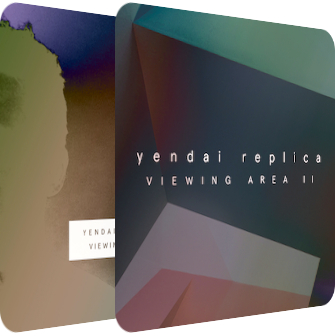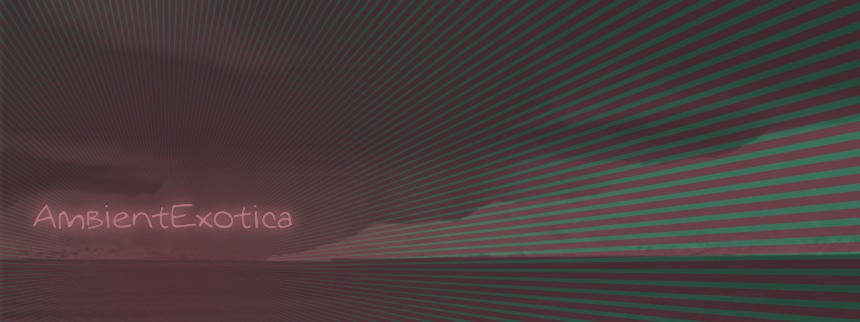
Yendai Replica
Viewing Area I + II
2014
Viewing Area is the debut album by London-based Ambient artist Yendai Replica, self-released in May 2014 in two parts which are both available on Bandcamp for free. The 13-track album is keen on maintaining a total immersion, a feat every Ambient artist can admittedly create with ease by stacking up a synth’s synth on a synth, but there is still that important distinction of aesthetics and a meaningful concept. This might be hurting Viewing Area on first sight, as the artist remains silent on the overarching driving factor. While it is noble to let the music speak for itself – a sentence that, alas, has become an empty hull – I for one would have been glad for catchphrase or a tag or two, no matter how mundane or picayune they may have seemed. However, here comes the beauty of this synth-coated album: it is remarkably coherent and brings across its semi-sinister technocratic vision via pictures before the inner eye. The front artworks are envisioned with darker color palettes, and these rectilineal areas resurface in aural form as well. A hybrid of a New Age gateway and a post-apocalyptic cyberspace endpoint, Viewing Area spawns all-encompassing synthesizers, droning legato washes and heavy reverb billows which serve both as temporary filters and an omniscient moiré. This is not to say that the world Yendai Replica creates is sorrowful – or even a world per se – for there are many comparably gleeful and enchanting tonalities to be found. The looming danger, however, is always near, making even the magnanimous moments of rest somewhat spoiled and apocryphal. There is much more to decrypt, but I will do that on a per-song basis in the following paragraphs.
Viewing Area I is filled with synth-driven nebulae that oscillate between an earthbound gravitas and ethereal glorifications thereof, freely giving in to many styles and traditions of Ambient music. The crystalline luminosity and seraphic superfluids of opener Warm Open Terminal are downright majestic, amalgamating reticulations of honeycomb coils and susurrant surfaces. This is a great start for the album itself, but not a good harbinger of the things to come, as Yendai Replica either enmeshes more clandestine spirits or diaphanous diffractions within the dualistic dioramas: Genesis Elodea meanwhile is a cherubic aquascape of prolonged syrinxes – or processed electric guitars – and granularly wraithlike organ underpinnings complete with solar wind gusts, whereas the two-minute sparkler Third Series System fathoms the interaction between sound, sustain and silence by letting threnodic doomsday sparks fly before a pitch-black backdrop whose sobriety is illumined by their hollow afterglow. The centerpiece Parallel Zones then carries the dichotomous simultaneity in its title already but knows to enchant regardless: angelic synth choirs are embedded in horticultural capsules and agglutinating piano prongs; there is even a koto-like breeze of pentatonicism included later on. Gyring between delight and compunction, this composition feels like the solaced aftermath of something. Probably the strongest take of the album’s first portion. While the murky Republican is loaded with stokehold steam pipes, lanthanum droplets and heating system circulation pumps in front of faraway drones, Clean Memory is yet again more keen on an extricating wideness with senescent-vernal tone sequences, longitudinal synth patterns and an aeriform purity, with the interim finale Subuya (Viewing) shuttling towards a sanguine streamlet as smooth as glass onto whose fluxion a rufescent ctenidium of radiator gills and choral vestiges is grafted.
Viewing Area II continues to absorb the New Age cataclysm of its precursor, Yendai Replica adds as much hope to his six sceneries as he is keen on veneering a looming portent. It turns out that this second part is much more benign and amicable though. The prelude Learning New Meaning runs for only a minute but has enough room to delineate the process of alteration: otherwise pristine icicles and aerial cataracts are harmed by a granular filter whose raspiness only increases the coldness. Horizon Palm is the counterpoint in this regard as it enthralls with a flittering glow of harmonious overtones, Angkor Wat chimes and cyber birds which are gleefully chirping within the boundaries of this fluorescent mirage. The following Remember is much more mephitic and smudgy by comparison, but otherwise sports the same physiognomy and tonal similitude. Its almost seething chords create a bustling cocoon, a shelter or sanctuary where one is safe and sound. The quavering panpipes, however, are still a no-go after all these decades and give this heartwarming womb an unwanted plastic quality. Suburbia meanwhile is the second interlude which barely crosses the mark of 60 seconds, presenting fleeting voices, hyperpolished concrete jungles and a liquedous coruscation. As it is common with such short pieces, one wishes them to continue for quite a bit longer. Xystoi Exist thankfully does just that, running for over five minutes, all of them filled with melodious synth pads of languor whose softly droning aurora is ameliorated with balmily sweeping shuffles and arpeggiated tendrils. Everything is aglow and verdured, only the cryptic addendum sounds empty and arcane, making room for the finale Silhouettes (Daniela), another panpipes-infested antrum of otherwise warmly stacked piano placentas, swooshing breezes and a decisive cross-linkage between these patterns. Reverb and blur round off the aforementioned duality by making this apotheosis piercingly blurry.
There is something disturbing about Viewing Area, this apprehension is hard to pinpoint by means of language, but no worries, as the reigning force is injected in these 13 tracks on purpose and is therefore part of the artistic vision. Granted, when reviewers speak about artistic visions, they do not even have a 50% chance to be at least somewhat correct, so let me explain: Viewing Area is a conglomerate of New Age, with pieces of virtual reality timbres and steampunk attitudes firmly in place. They bring with them a looming danger, a kind of ongoing horror that is sometimes more, sometimes less apparent within the boundaries of a track. Even when Yendai Replica lures the listener with outrageously beautiful synth textures with seemingly matching tone sequences of delight and contentment as is most often the case on Part II of the album, this is a serious release, meaning that there is an oppressive scheme, an omnipresent countermovement embroidered, lurking all the time. Both the front artworks and traditions of New Age match this impression. Viewing Area is a great release for synth lovers, and even though it should have been released as one contiguous album right from the get-go and gotten rid of the panpipes textures, I can still approve of the unmentioned float and string of destinations. Fans of this synth-heavy kind of Ambient music should also check out young artist Sircle aka James Mills’ A Relevant Space (2013) which is specifically written for floatation tanks and sports thickly wadded synthesizer architectures similar to Yendai Replica’s two-part work.
Further listening and reading:
- Viewing Area is available for free at Bandcamp.
- Yendai Replica's Twitter account: @yendaireplica.
Ambient Review 348: Yendai Replica – Viewing Area I + II (2014). Originally published on Jun. 4, 2014 at AmbientExotica.com.
